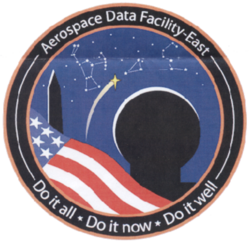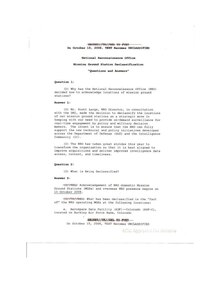Aerospace Data Facility-East
| Aerospace Data Facility-East | |
|---|---|
| Part of Fort Belvoir | |
| Fairfax County, Virginia | |
 | |
| Coordinates | 38°44′10″N 77°9′30″W / 38.73611°N 77.15833°W |
| Type | Satellite ground station |
| Site information | |
| Owner | United States Army |
| Controlled by | National Reconnaissance Office |
| Site history | |
| In use | 1977–present |
| Garrison information | |
| Current commander | Col. Nicholas Martin |
Aerospace Data Facility-East (ADF-E), also known as Area 58 and formerly known as Defense Communications Electronics Evaluation and Testing Activity (DCEETA), is one of three satellite ground stations operated by the National Reconnaissance Office (NRO) in the continental United States. Located within Fort Belvoir, Virginia, the facility is responsible for the command and control of reconnaissance satellites involved in the collection of intelligence information and for the dissemination of that intelligence to other U.S. government agencies.[1]
Function
ADF East is co-located with elements of the National Geospatial-Intelligence Agency, the agency responsible for the operation of the U.S. space-based imagery constellation.[2][3] Authors James Bamford and Jeffrey Richelson report that the site manages the KH-11 imagery spacecraft and the Lacrosse radar imaging spacecraft.[3][4] NASA engineer Ken Young, who visited the site as part of a plan for KH-11 to photograph STS-1, described its equipment as far more sophisticated than at his agency.[5]
History

First use
The first documented use of material downloaded at ADF East was on January 21, 1977, when the acting director of Central Intelligence E. Henry Knoche delivered reconnaissance satellite photographs that had been downloaded at ADF East to U.S. President Jimmy Carter.[6][verification needed]
Y2K
On the morning of January 1, 2000, ADF East experienced a technical glitch caused by the Y2K bug, which resulted in the facility being temporarily unable to capture any more than 70 percent of its planned imagery satellite coverage.[2] At a press conference on January 4, United States Deputy Secretary of Defense John Hamre stated, "The problem wasn't with the satellite system – they were under positive control at all times. The problem was on the ground in the processing station."[7][8]
Declassification

On October 15, 2008, the NRO declassified its three Mission Ground Stations: ADF-East, ADF-Colorado, and ADF-Southwest.[1][9] [10][11]
List of commanders
- Col B. Edwin Wilson, September 2006 – April 2008
- Col Anthony J. Cotton, April 2008 – July 2019
- Col Todd J. Benson, July 2019 – July 2021[12]
- Col Nicholas Martin
See also
- Aerospace Data Facility-Colorado
- Aerospace Data Facility-Southwest
- Pine Gap
- RAF Menwith Hill
- Spy satellite
References
- ^ a b National Reconnaissance Office, Mission Ground Station Declassification, Questions and Answers
- ^ a b Lardner, Richard (January 13, 2000). "Pre-Y2K Problems Undercut Operation of U.S. Satellite Imagery Network". InsideDefense.com. Archived from the original on September 24, 2010. Retrieved 2008-10-07.
- ^ a b Richelson, Jeffrey (1999). The U.S. Intelligence Community (4th ed.). Boulder, Colorado: Westview Press. pp. 171. ISBN 0813368936.
- ^ Bamford, James (January 13, 1985). "America's Supersecret Eyes In Space". The New York Times.
- ^ White, Rowland (2017-04-12). "The Spysat and the Shuttle". Air & Space. Retrieved 2024-12-02.
- ^ Burrows, William (1986). Deep Black: Space Espionage and National Security. New York: Random House. pp. 225–227. ISBN 0394541243.
- ^ Garamone, Jim (January 3, 2000). "Y2K has little effect on military operations". Government Executive. Archived from the original on June 29, 2013. Retrieved 2008-10-07.
- ^ John Hamre (January 4, 2000). "DoD News Briefing". Federation of American Scientists. Retrieved 2008-10-07.
- ^ Day, Dwayne (June 1, 2009). "Look! Up in the air! No, down on the ground! The NRO's domestic ground stations". The Space Review.
- ^ "National Reconnaissance Office Review and Redaction Guide" (PDF). Version 1.0. 2006: 31.
{{cite journal}}: Cite journal requires|journal=(help) - ^ "NRO Releases Compendium of Declassified Data". Secrecy News (59). June 7, 2007. Retrieved 2008-10-07.
- ^ "Colonel Todd J. Benson, United States Air Force (bio)" (PDF). opce.uah.edu. March 2024. Retrieved October 3, 2024.
Further reading
- Burrows, William (1986). Deep Black: Space Espionage and National Security. New York: Random House. ISBN 0394541243.
